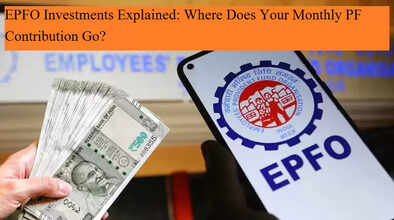EPFO Investments Explained: Where Does Your Monthly PF Contribution Go?

Every month, a portion of your salary gets deducted as Provident Fund (PF), but have you ever wondered where exactly that money goes? Is it just sitting in a savings account, or does the Employees' Provident Fund Organisation (EPFO) invest it elsewhere? Understanding the journey of your hard-earned retirement fund is crucial for your long-term financial planning.
How Much Do You and Your Employer Contribute?
As per EPFO rules, all companies with 20 or more employees are mandated to enroll in the Provident Fund Scheme. Both employees and employers are required to contribute 12% of the employee’s basic salary each month.
-
Employee’s 12% Contribution: Goes entirely into the EPF (Employees' Provident Fund) account.
-
Employer’s 12% Contribution: This gets split into three components:
-
8.33% towards EPS (Employees’ Pension Scheme)
-
3.67% into the EPF account
-
A small additional portion goes towards EDLI (Employees' Deposit Linked Insurance Scheme).
-
This distribution explains why your employer’s contribution appears less in your PF passbook, even though they are contributing the full 12%.
Breakdown Example:
Assume your basic salary is ₹20,000.
-
Your 12% contribution (₹2,400) goes entirely into your EPF account.
-
Employer’s contribution of ₹2,400 is divided as:
-
₹1,666 (8.33%) into EPS.
-
₹734 (3.67%) into EPF.
-
Additional amount towards EDLI insurance.
-
Thus, while it may seem like the employer is contributing less to your EPF balance, a significant portion is being allocated for your future pension and insurance benefits.
Why This Split?
The system is designed not just to build a lump-sum retirement corpus but also to ensure you receive regular pension income after retirement. The EPS contribution is locked until you reach retirement age (with some exceptions), promoting long-term financial stability.
-
If you leave employment before completing 10 years, you can withdraw the EPS portion by submitting Form 10C.
-
If you work for 10 years or more, you become eligible for a monthly pension after age 58.
Where Does EPFO Invest Your Money?
EPFO doesn’t keep your contributions idle in cash. Instead, it invests these funds in secure, low-risk instruments to generate stable returns while ensuring the safety of your capital. The key investment avenues are:
-
Government Bonds & Securities: A large portion is invested here for assured returns and capital safety.
-
Corporate Bonds: Select bonds from reputed public and private sector companies.
-
Equity Exposure (ETFs): Over the last few years, EPFO has started investing up to 15% of its annual accruals in Exchange-Traded Funds (ETFs) linked to stock markets to improve long-term returns, while still prioritizing safety.
Focus on Stability Over High Risk
EPFO’s investment strategy is conservative, aimed at delivering steady and predictable returns. While the equity exposure via ETFs introduces potential for higher growth, the overall approach remains cautious, ensuring your retirement corpus is shielded from market volatility.
Conclusion
Your PF contributions are not just a savings deduction; they are a well-structured retirement plan. With allocations to EPF, EPS, and EDLI, and strategic investments by EPFO, this scheme aims to provide both a lump-sum amount and a regular pension income after retirement, making it a comprehensive financial safety net for employees.

